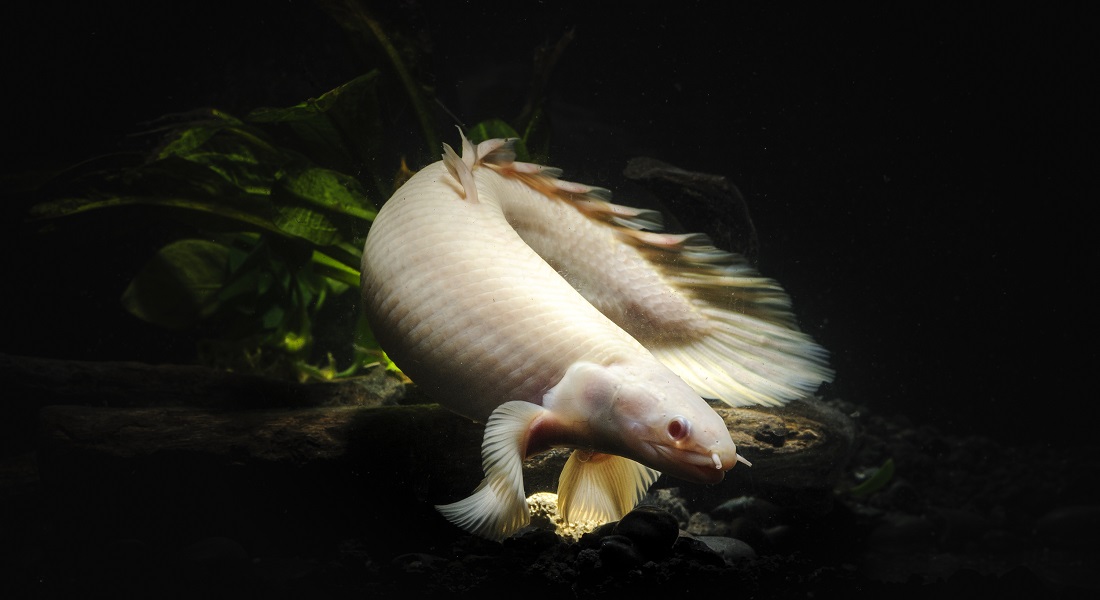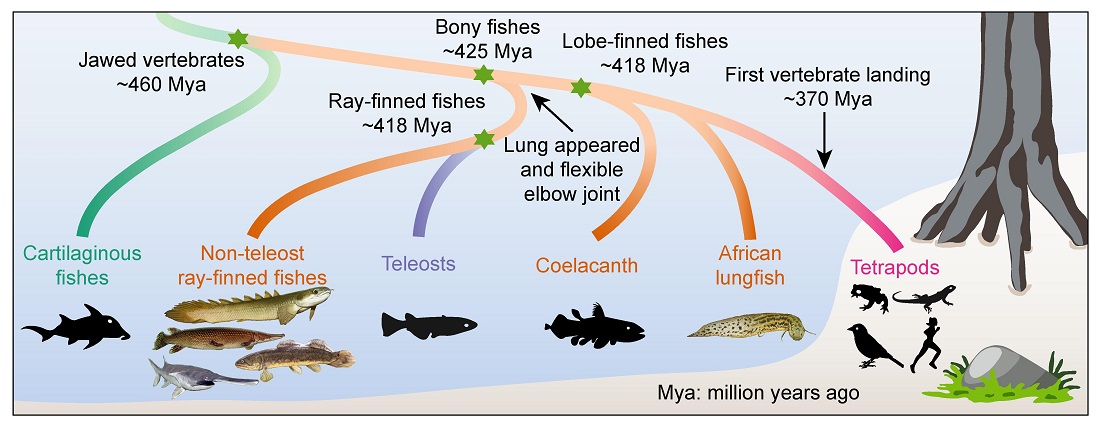We’re more like primitive fishes than once believed
People traditionally think that lungs and limbs are key innovations that came with the vertebrate transition from water to land. But in fact, the genetic basis of air-breathing and limb movement was already established in our fish ancestor 50 million years earlier. This, according to a recent genome mapping of primitive fish conducted by the University of Copenhagen, among others. The new study changes our understanding of a key milestone in our own evolutionary history.

There is nothing new about humans and all other vertebrates having evolved from fish. The conventional understanding has been that certain fish shimmied landwards roughly 370 million years ago as primitive, lizard-like animals known as tetrapods. According to this understanding, our fish ancestors came out from water to land by converting their fins to limbs and breathing under water to air-breathing.
However, limbs and lungs are not innovations that appeared as recent as once believed. Our common fish ancestor that lived 50 million years before the tetrapod first came ashore already carried the genetic codes for limb-like forms and air breathing needed for landing. These genetic codes are still present in humans and a group of primitive fishes. This has been demonstrated by recent genomic research conducted by University of Copenhagen and their partners. The new research reports that the evolution of these ancestral genetic codes might have contributed to the vertebrate water-to-land transition, which changes the traditional view of the sequence and timeline of this big evolutionary jump. The study has been published in the scientific journal Cell.
"The water-to-land transition is a major milestone in our evolutionary history. The key to understanding how this transition happened is to reveal when and how the lungs and limbs evolved. We are now able to demonstrate that biological functions occurred much earlier before the first animals came ashore," stated by professor and lead author Guojie Zhang, from Villum Centre for Biodiversity Genomics, at the University of Copenhagen’s Department of Biology.
Our synovial joint evolved from fish ancestor
Using pectoral fins with a locomotor function like limbs, the bichir can move about on land in a similar way to the tetrapod. Researchers have for some years believed that pectoral fins in bichir represent the fins that our early fish ancestors had.
The new genome mapping shows that the joint which connects the socalled metapterygium bone with the radial bones in the pectoral fin in the bichir is homologous to the synovial joints in humans - the joints that connect upper arm and forearm bones. The DNA sequence that controls the formation of our synovial joints already existed in the common ancestors of bonefish and is still present in these primitive fishes and in terrestrial vertebrates. At some point, this DNA sequence and the synovial joint was lost in all of the common bony fishes – the socalled teleosts.
"This genetic code and the joint allows our bones move freely, which explains why the bichir can move around on land," says Guojie Zhang.
First lungs, then swim bladder
Moreover, the bichir and a few other primitive fishes have a pair of lungs that anatomically resembles ours. The new study reveals that the lungs in both bichir and alligator gar also function in a similar manner and express same set of genes as human lungs.
At the same time, the study demonstrates that the tissue of the lung and swim bladder of most extant fishes are very similar in gene expression, confirming they are homologous organs as predicted by Darwin. But while Darwin suggested that swim bladders converted to lungs, the study suggests it is more likely that swim bladders evolved from lungs. The research suggests that our early bony fish ancestors had primitive functional lungs. Through evolution, one branch of fish preserved the lung functions that are more adapted to air breathing and ultimately led to the evolution of tetrapods. The other branch of fishes modified the lung structure and evolved with swim bladders, leading the evolution of teleosts. The swim bladders allow these fishes to maintain buoyancy and perceive pressure, thus better survive under water.
"The study enlightens us with regards to where our body organs came from and how their functions are decoded in the genome. Thus, some of the functions related to lung and limbs did not evolve at the time when the water-to-land transition occurred, but are encoded by some ancient gene regulatory mechanisms that were already present in our fish ancestor far before landing. It is interesting that these genetic codes are still present in these ‘living-fossil’’ fishes, which offer us the opportunity to trace back the root of these genes," concludes Guojie Zhang.

Not just limbs and lungs, but also the heart
Primitive fish and humans also share a common and critical function in the cardio-respiratory system: The conus arteriosus, a structure in the right ventricle of our heart which might allow the heart to efficiently deliver the oxygen to the whole body, and which is also found in the bichir. However, the vast majority of bony fish have lost this structure. The researchers discovered a genetic element that appears to control the development of the conus arteriosus. Transgenic experiments with mice showed that when researchers removed this genetic element, the mutated mice died due to thinner, smaller right ventricles, which lead to congenital heart defects and compromised heart function.
Topics
Contact
Guojie Zhang
Professor
Department of Biology
University of Copenhagen
Guojie.Zhang@bio.ku.dk
+45 35 32 12 92
Maria Hornbek
Journalist
Faculty of Science
University of Copenhagen
maho@science.ku.dk
+45 22 95 42 83
Facts
- The vast majority of extant fish species belong to the ray-finned fishes, a subclass of bony fish. These are typically fish with gills, fins and a swim bladder.
- The terrestrial group of vertebrates are known as tetrapod. The tetrapod includes all vertebrates that descended from the first animals adapted to a life on land by developing four limbs and lungs, i.e., all mammals, birds, reptiles and amphibians.
- The researchers' theory is that the allowed them to survive the second mass extinction roughly 375-360 million years ago. At that time, oxygen depletion in Earth’s oceans caused a majority of species to be wiped out. Lungs allowed some fish to survive on land.
- The study has been published in the scientific journal Cell. Access the research article here. The research team also contributed to another paper which reported the genome for another primitive fish, the lungfish. The genome is the biggest vertebrate genome decoded so far. This paper was published in Cell at the same time.
- The research is supported by the Villum Foundation, among others.
